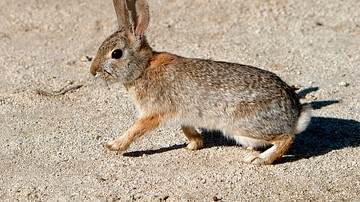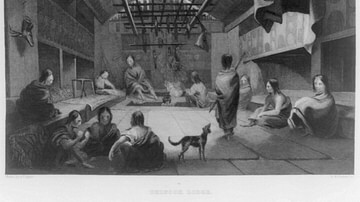In the lore of the Cherokee nation, the rabbit is a trickster figure living by its wits, who sometimes outsmarts adversaries or predators and sometimes is defeated by them, though, even in defeat, the rabbit usually escapes. The rabbit symbolizes abundance and fertility to the Native peoples of North America generally but is also recognized for its speed and cleverness.

Among the most popular myths of the Cherokee are the rabbit tales in which the rabbit finds himself in some sort of trouble, almost always brought on by himself, and must find a way out of these difficulties. There are many such tales, but four of the most popular are The Rabbit Goes Duck Hunting, How the Rabbit Stole the Otter's Coat, How the Terrapin Beat the Rabbit, and Flint Visits the Rabbit, all four given below.
The rabbit tales are often origin myths explaining how things came to be – such as why the rabbit looks as it does or why there is an abundance of flint in a given area – but can also be cautionary tales on knowing one's place, the importance of humility, and the value of quick thinking and outsmarting an adversary. Like other trickster figures in Native American lore, the rabbit can appear as the hero of the tale, the villain, or simply as a foolish figure who fails to achieve his goals due to a fatal flaw in his character.
Text
The following are taken from Myths of the Cherokee (1900) by James Mooney, republished by Dover Publications in 2014.
The Rabbit Goes Duck Hunting
The Rabbit was so boastful that he would claim to do whatever he saw anyone else do, and so tricky that he could usually make the other animals believe it all. Once he pretended that he could swim in the water and eat fish just as the Otter did, and when the others told him to prove it, he fixed up a plan so that the Otter himself was deceived.
Soon afterward they met again, and the Otter said, "I eat ducks sometimes." Said the Rabbit, "Well, I eat ducks too." The Otter challenged him to try it; so they went up along the river until they saw several ducks in the water and managed to get near without being seen. The Rabbit told the Otter to go first. The Otter never hesitated but dived from the bank and swam under water until he reached the ducks, when he pulled one down without being noticed by the others and came back in the same way.
While the Otter had been under the water the Rabbit had peeled some bark from a sapling and made himself a noose. "Now," he said, "Just watch me;" and he dived in and swam a little way under the water until he was nearly choking and had to come up to the top to breathe. He went under again and came up again a little nearer to the ducks. He took another breath and dived under, and this time he came up among the ducks and threw the noose over the head of one and caught it. The duck struggled hard and finally spread its wings and flew up from the water with the Rabbit hanging on to the noose.
It flew on and on until, at last, the Rabbit could not hold on any longer, but had to let go and drop. As it happened, he fell into a tall, hollow sycamore stump without any hole at the bottom to get out from, and there he stayed until he was so hungry that he had to eat his own fur, as the rabbit does ever since when he is starving. After several days, when he was very weak with hunger, he heard children playing outside around the trees. He began to sing:
Cut a door and look at me;
I'm the prettiest thing you ever did see.
The children ran home and told their father, who came and began to cut a hole in the tree. As he chopped away, the Rabbit inside kept singing, "Cut it larger, so you can see me better; I'm so pretty." They made the hole larger, and then the Rabbit told them to stand back so that they could take a good look as he came out. They stood away back, and the Rabbit watched his chance and jumped out and got away.
How the Rabbit Stole the Otter's Coat
The animals were of different sizes and wore coats of various colors and patterns. Some wore long fur and others wore short. Some had rings on their tails, and some had no tails at all. Some had coats of brown, others of black or yellow. They were always disputing about their good looks, so at last they agreed to hold a council to decide who had the finest coat.
They had heard a great deal about the Otter, who lived so far up the creek that he seldom came down to visit the other animals. It was said that he had the finest coat of all, but no one knew just what it was like, because it was a long time since anyone had seen him. They did not even know exactly where he lived—only the general direction; but they knew he would come to the council when the word got out.
Now the Rabbit wanted the verdict for himself, so when it began to look as if it might go to the Otter, he studied up a plan to cheat him out of it. He asked a few sly questions until he learned what trail the Otter would take to get to the council place. Then, without saying anything, he went on ahead and after four days' travel, he met the Otter and knew him at once by his beautiful coat of soft dark-brown fur. The Otter was glad to see him and asked him where he was going. "O," said the Rabbit, "the animals sent me to bring you to the council; because you live so far away, they were afraid you mightn't know the road." The Otter thanked him, and they went on together.
They traveled all day toward the council ground, and at night the Rabbit selected the camping place, because the Otter was a stranger in that part of the country and cut down bushes for beds and fixed everything in good shape. The next morning, they started on again. In the afternoon the Rabbit began to pick up wood and bark as they went along and to load it on his back. When the Otter asked what this was for the Rabbit said it was that they might be warm and comfortable at night. After a while, when it was near sunset, they stopped and made their camp.
When supper was over the Rabbit got a stick and shaved it down to a paddle. The Otter wondered and asked again what that was for.
"I have good dreams when I sleep with a paddle under my head," said the Rabbit.
When the paddle was finished the Rabbit began to cut away the bushes so as to make a clean trail down to the river. The Otter wondered more and more and wanted to know what this meant.
Said the Rabbit, "This place is called Di′tatlâski′yĭ [The Place Where It Rains Fire]. Sometimes it rains fire here, and the sky looks a little that way to-night. You go to sleep, and I'll sit up and watch, and if the fire does come, as soon as you hear me shout, you run and jump into the river. Better hang your coat on a limb over there, so it won't get burnt."
The Otter did as he was told, and they both doubled up to go to sleep, but the Rabbit kept awake. After a while the fire burned down to red coals. The Rabbit called, but the Otter was fast asleep and made no answer. In a little while he called again, but the Otter never stirred. Then the Rabbit filled the paddle with hot coals and threw them up into the air and shouted, "It's raining fire! It's raining fire!"
The hot coals fell all around the Otter, and he jumped up. "To the water!" cried the Rabbit, and the Otter ran and jumped into the river, and he has lived in the water ever since.
The Rabbit took the Otter's coat and put it on, leaving his own instead, and went on to the council. All the animals were there, everyone looking out for the Otter. At last, they saw him in the distance, and they said one to the other, "The Otter is coming!" and sent one of the small animals to show him the best seat. They were all glad to see him and went up in turn to welcome him, but the Otter kept his head down, with one paw over his face. They wondered that he was so bashful, until the Bear came up and pulled the paw away, and there was the Rabbit with his split nose. He sprang up and started to run, when the Bear struck at him and pulled his tail off, but the Rabbit was too quick for them and got away.
How the Terrapin Beat the Rabbit
The Rabbit was a great runner, and everybody knew it. No one thought the Terrapin anything but a slow traveler, but he was a great warrior and very boastful, and the two were always disputing about their speed. At last, they agreed to decide the matter by a race. They fixed the day and the starting place and arranged to run across four mountain ridges, and the one who came in first at the end was to be the winner.
The Rabbit felt so sure of it that he said to the Terrapin, "You know you can't run. You can never win the race, so I'll give you the first ridge and then you'll have only three to cross while I go over four."
The Terrapin said that would be all right, but that night when he went home to his family, he sent for his Terrapin friends and told them he wanted their help. He said he knew he could not outrun the Rabbit, but he wanted to stop the Rabbit's boasting. He explained his plan to his friends, and they agreed to help him.
When the day came all the animals were there to see the race. The Rabbit was with them, but the Terrapin was gone ahead toward the first ridge, as they had arranged, and they could hardly see him on account of the long grass. The word was given, and the Rabbit started off with long jumps up the mountain, expecting to win the race before the Terrapin could get down the other side. But before he got up the mountain, he saw the Terrapin go over the ridge ahead of him.
He ran on, and when he reached the top, he looked all around but could not see the Terrapin on account of the long grass. He kept on down the mountain and began to climb the second ridge, but when he looked up again there was the Terrapin just going over the top. Now he was surprised and made his longest jumps to catch up, but when he got to the top there was the Terrapin away in front going over the third ridge. The Rabbit was getting tired now and nearly out of breath, but he kept on down the mountain and up the other ridge until he got to the top just in time to see the Terrapin cross the fourth ridge and thus win the race.
The Rabbit could not make another jump, but fell over on the ground, crying mĭ, mĭ, mĭ, mĭ, as the Rabbit does ever since when he is too tired to run any more. The race was given to the Terrapin and all the animals wondered how he could win against the Rabbit, but he kept still and never told. It was easy enough, however, because all the Terrapin's friends looked just alike, and he had simply posted one near the top of each ridge to wait until the Rabbit came in sight and then climb over and hide in the long grass.
When the Rabbit came on he could not find the Terrapin and so thought the Terrapin was ahead, and if he had met one of the other terrapins he would have thought it the same one because they looked so much alike. The real Terrapin had posted himself on the fourth ridge, so as to come in at the end of the race and be ready to answer questions if the animals suspected anything.
Because the Rabbit had to lie down and lose the race the conjurer now, when preparing his young men for the ball play, boils a lot of rabbit hamstrings into a soup, and sends someone at night to pour it across the path along which the other players are to come in the morning, so that they may become tired in the same way and lose the game. It is not always easy to do this, because the other party is expecting it and has watchers ahead to prevent it.
Flint Visits the Rabbit
In the old days Tăwi′skălă (Flint) lived up in the mountains, and all the animals hated him because he had helped to kill so many of them. They used to get together to talk over means to put him out of the way, but everybody was afraid to venture near his house until the Rabbit, who was the boldest leader among them, offered to go after Flint and try to kill him. They told him where to find him, and the Rabbit set out and at last came to Flint's house.
Flint was standing at his door when the Rabbit came up and said, sneeringly, "Siyu′! Hello! Are you the fellow they call Flint?" "Yes; that's what they call me," answered Flint. "Is this where you live?" "Yes; this is where I live." All this time the Rabbit was looking about the place trying to study out some plan to take Flint off his guard. He had expected Flint to invite him into the house, so he waited a little while, but when Flint made no move, he said, "Well, my name is Rabbit; I've heard a good deal about you, so I came to invite you to come and see me."
Flint wanted to know where the Rabbit's house was, and he told him it was down in the broom-grass field near the river. So, Flint promised to make him a visit in a few days. "Why not come now and have supper with me?" said the Rabbit, and after a little coaxing Flint agreed and the two started down the mountain together.
When they came near the Rabbit's hole the Rabbit said, "There is my house, but in summer I generally stay outside here where it is cooler." So, he made a fire, and they had their supper on the grass. When it was over, Flint stretched out to rest and the Rabbit got some heavy sticks and his knife and cut out a mallet and wedge. Flint looked up and asked what that was for. "Oh," said the Rabbit, "I like to be doing something, and they may come handy." So, Flint lay down again, and pretty soon he was sound asleep. The Rabbit spoke to him once or twice to make sure, but there was no answer.
Then he came over to Flint and with one good blow of the mallet he drove the sharp stake into his body and ran with all his might for his own hole; but before he reached it there was a loud explosion, and pieces of flint flew all about. That is why we find flint in so many places now. One piece struck the Rabbit from behind and cut him just as he dived into his hole. He sat listening until everything seemed quiet again. Then he put his head out to look around, but just at that moment another piece fell and struck him on the lip and split it, as we still see it.





